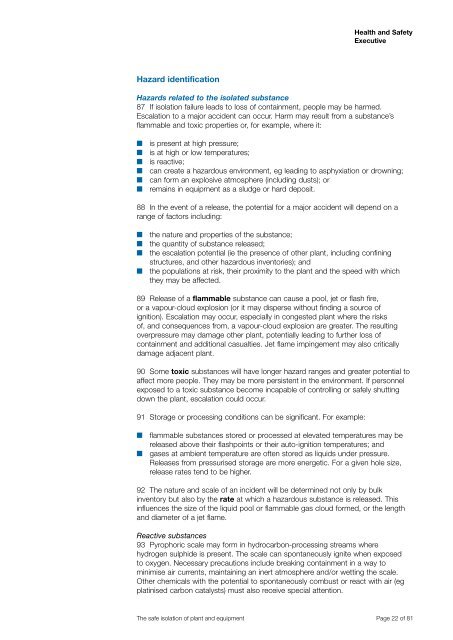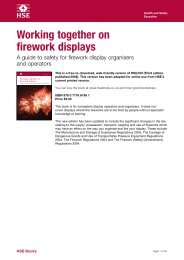The safe isolation of plant and equipment (HSG253) - Health and ...
The safe isolation of plant and equipment (HSG253) - Health and ...
The safe isolation of plant and equipment (HSG253) - Health and ...
You also want an ePaper? Increase the reach of your titles
YUMPU automatically turns print PDFs into web optimized ePapers that Google loves.
Hazard identification<br />
<strong>Health</strong> <strong>and</strong> Safety<br />
Executive<br />
Hazards related to the isolated substance<br />
87 If <strong>isolation</strong> failure leads to loss <strong>of</strong> containment, people may be harmed.<br />
Escalation to a major accident can occur. Harm may result from a substance’s<br />
flammable <strong>and</strong> toxic properties or, for example, where it:<br />
■<br />
■<br />
■<br />
■<br />
■<br />
■<br />
is present at high pressure;<br />
is at high or low temperatures;<br />
is reactive;<br />
can create a hazardous environment, eg leading to asphyxiation or drowning;<br />
can form an explosive atmosphere (including dusts); or<br />
remains in <strong>equipment</strong> as a sludge or hard deposit.<br />
88 In the event <strong>of</strong> a release, the potential for a major accident will depend on a<br />
range <strong>of</strong> factors including:<br />
■<br />
■<br />
■<br />
■<br />
the nature <strong>and</strong> properties <strong>of</strong> the substance;<br />
the quantity <strong>of</strong> substance released;<br />
the escalation potential (ie the presence <strong>of</strong> other <strong>plant</strong>, including confining<br />
structures, <strong>and</strong> other hazardous inventories); <strong>and</strong><br />
the populations at risk, their proximity to the <strong>plant</strong> <strong>and</strong> the speed with which<br />
they may be affected.<br />
89 Release <strong>of</strong> a flammable substance can cause a pool, jet or flash fire,<br />
or a vapour-cloud explosion (or it may disperse without finding a source <strong>of</strong><br />
ignition). Escalation may occur, especially in congested <strong>plant</strong> where the risks<br />
<strong>of</strong>, <strong>and</strong> consequences from, a vapour-cloud explosion are greater. <strong>The</strong> resulting<br />
overpressure may damage other <strong>plant</strong>, potentially leading to further loss <strong>of</strong><br />
containment <strong>and</strong> additional casualties. Jet flame impingement may also critically<br />
damage adjacent <strong>plant</strong>.<br />
90 Some toxic substances will have longer hazard ranges <strong>and</strong> greater potential to<br />
affect more people. <strong>The</strong>y may be more persistent in the environment. If personnel<br />
exposed to a toxic substance become incapable <strong>of</strong> controlling or <strong>safe</strong>ly shutting<br />
down the <strong>plant</strong>, escalation could occur.<br />
91 Storage or processing conditions can be significant. For example:<br />
■<br />
■<br />
flammable substances stored or processed at elevated temperatures may be<br />
released above their flashpoints or their auto-ignition temperatures; <strong>and</strong><br />
gases at ambient temperature are <strong>of</strong>ten stored as liquids under pressure.<br />
Releases from pressurised storage are more energetic. For a given hole size,<br />
release rates tend to be higher.<br />
92 <strong>The</strong> nature <strong>and</strong> scale <strong>of</strong> an incident will be determined not only by bulk<br />
inventory but also by the rate at which a hazardous substance is released. This<br />
influences the size <strong>of</strong> the liquid pool or flammable gas cloud formed, or the length<br />
<strong>and</strong> diameter <strong>of</strong> a jet flame.<br />
Reactive substances<br />
93 Pyrophoric scale may form in hydrocarbon-processing streams where<br />
hydrogen sulphide is present. <strong>The</strong> scale can spontaneously ignite when exposed<br />
to oxygen. Necessary precautions include breaking containment in a way to<br />
minimise air currents, maintaining an inert atmosphere <strong>and</strong>/or wetting the scale.<br />
Other chemicals with the potential to spontaneously combust or react with air (eg<br />
platinised carbon catalysts) must also receive special attention.<br />
<strong>The</strong> <strong>safe</strong> <strong>isolation</strong> <strong>of</strong> <strong>plant</strong> <strong>and</strong> <strong>equipment</strong> Page 22 <strong>of</strong> 81







